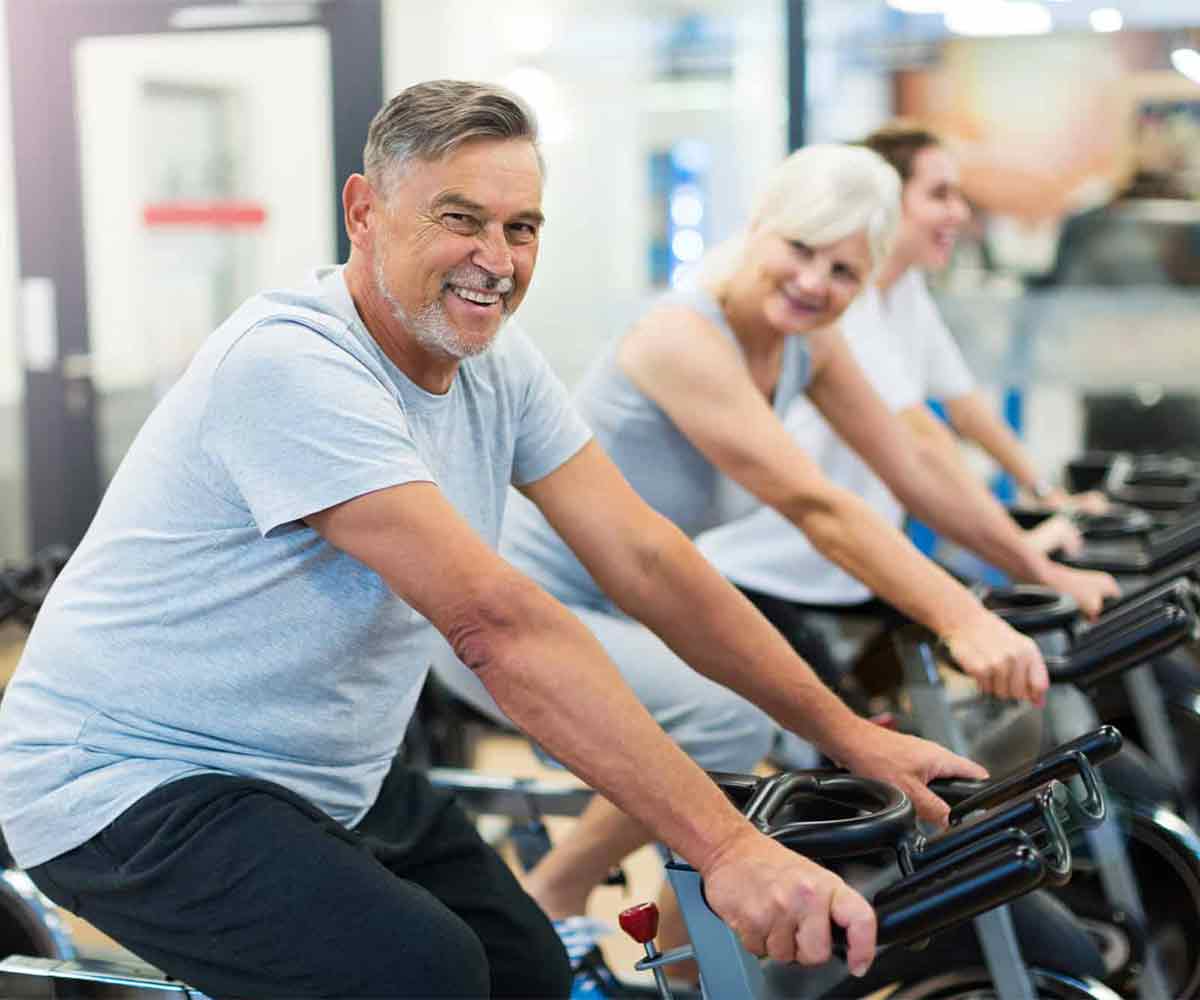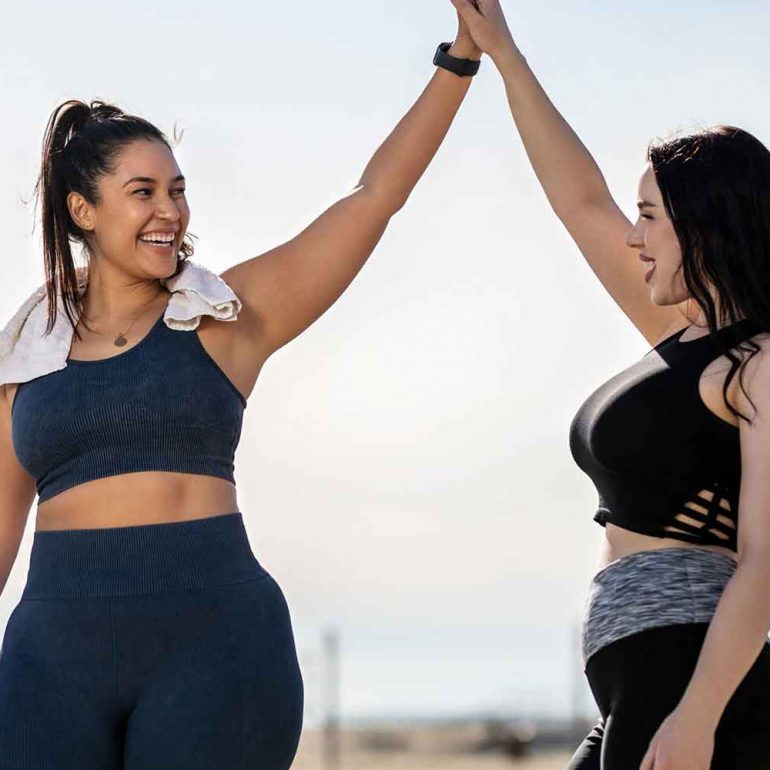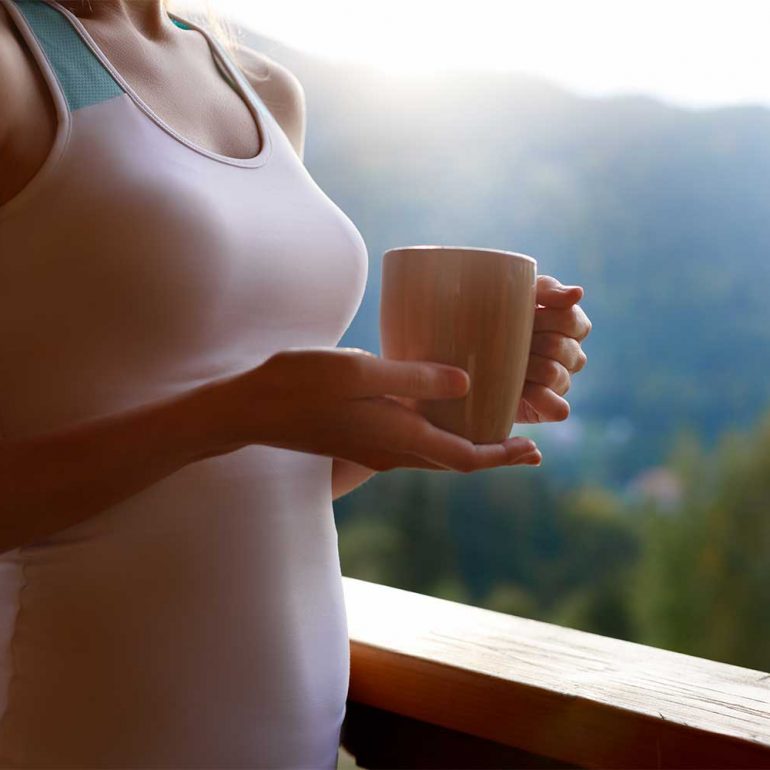Want to achieve superior health and slow the aging process? We know the Nutritarian diet is the foundational principle, but there are additional actions you need to take to push the envelope on longevity and enjoying your years ahead. First: Eat a diet of whole plant foods, which is rich in phytochemicals and essential nutrients. Second: Practice moderate calorie restriction. Third: Exercise.
These three factors slow all the processes associated with biological aging. When your body fat is lower and you do not overeat, your metabolism slows down a bit. A slower metabolism is one of the components of aging more slowly.1 A high level of physical activity is also linked to longevity, as well as a reduced risk of cardiovascular disease and many different types of cancer.2-4
Sources:
- Higher energy expenditure in humans predicts natural mortality
- Association of Leisure-Time Physical Activity With Risk of 26 Types of Cancer in 1.44 Million Adults.
- Leisure-time physical activity and mortality: a detailed pooled analysis of the dose-response relationship.
- Physical activity and risk of cardiovascular disease–a meta-analysis of prospective cohort studies.
A Pro-Brainer to Slow Aging
You know how exercise can leave you feeling amazing? The natural mood-elevating effects of exercise make it a helpful component of treatment for depression.5 Regular exercise is associated with a reduced risk of dementia and depression.6-8
There is an abundance of research suggesting exercise helps improve cognitive function and mood, and it’s more than just enhancing blood flow to the brain. The studies suggest exercise helps the brain produce new neurons and create connections and circuitry that improve learning and memory.9,10
Related: Build muscle to build a better brain.
Sources:
- Leisure-time physical activity and dementia risk: a dose-response meta-analysis of prospective studies.
- Physical activity and the prevention of depression: a systematic review of prospective studies.
- Depression and Objectively Measured Physical Activity: A Systematic Review and Meta-Analysis.
- Depression and Anxiety Disorders: Benefits of Exercise, Yoga, and Meditation.
- Exercise for Brain Health: An Investigation into the Underlying Mechanisms Guided by Dose.
- Trends in exercise neuroscience: raising demand for brain fitness.
Cardiovascular Health
Physical activity not only gets your blood pumping – it keeps your heart thumping. Regular exercise lowers blood pressure and reduces the risk of heart disease and stroke.4,11 Heart muscle cells adapt to exercise by increasing their size and enhancing their energy production capacity. The heart’s adaptations to exercise contribute to protection from future heart disease.12
In the blood vessels, exercise works by reducing oxidative stress, increasing production of nitric oxide which helps keep blood pressure down, decreased vascular stiffness, and reducing the likelihood of clot formation.13
Action Item: Keep moving. Go for a jog or power walk daily. Try jumping jacks, “magic” jump rope (use an imaginary rope), burpees, climbing stairs, or jogging in place to get your heart rate up.
Sources:
- Physical activity and risk of cardiovascular disease–a meta-analysis of prospective cohort studies. Exercise training for blood pressure: a systematic review and meta-analysis.
- Molecular Mechanisms Underlying Cardiac Adaptation to Exercise.
Insulin Sensitivity and Blood Glucose to Slow Aging
Looking for another reason to make exercise part of your daily routine? It improves your blood glucose and insulin sensitivity, whether or not you have diabetes.
During exercise, glucose is moved quickly out of the blood and into the muscles to be burned for energy. Both aerobic and resistance exercise have reduced HbA1c, an indicator of long-term glycemic control, in patients with type 2 diabetes.14,15
Sources:
- Exercise training modalities in patients with type 2 diabetes mellitus: a systematic review and network meta-analysis.
- The Effect of Physical Activity Interventions on Glycosylated Haemoglobin (HbA1c) in Non-diabetic Populations: A Systematic Review and Meta-analysis.
Preventing Falls and Fractures to Slow Aging
The protective benefits of exercise are increased when you add weights, especially as we age. In older adults, falls and bone fractures can be serious setbacks that reduce independence and diminish quality of life and life expectancy. Regular exercise reduces the risk of falls and fractures;16 when you put weight-bearing exercise into the mix, it puts mechanical stresses on bone tissue. This sends signals to the bone to adapt by getting stronger; as we age, this helps slow age-related bone loss.17
Related: Preventing Osteoporosis
Action Item: Osteoporosis Protection for Life (Video-on-demand, free for members of DrFuhrman.com)
Action Item: One-legged toe raises. Here’s an exercise from my Osteoporosis Protection for Life video (which is available free for members). To do one-legged toe raises, stand on one foot; with the ball of your foot on the edge of a step or staircase and holding on to the banister, slowly rise up on tiptoe, then carefully lower that heel as low as you can below the level of the step. Start with five reps on each side, and over time, work up to fifteen reps with each leg. Really feel the stretch in your calf as you lower down from tiptoe.
Sources:
- Association of Long-term Exercise Training With Risk of Falls, Fractures, Hospitalizations, and Mortality in Older
- Adults: A Systematic Review and Meta-analysis.
- How Physical Activity across the Lifespan Can Reduce the Impact of Bone Ageing: A Literature Review.
A Good Workout at Home to Slow Aging
Skip the gym – but not your workout! Here are some exercises that require no special equipment or just a few basic items. Squats and push-ups are some of the classic no-equipment strength moves, but there are lots of other options. Remember, you can use your body to create resistance for strength exercises.
If you only have ten minutes, you can still exercise. Break up your daily exercise activity into small chunks of time – say, ten to fifteen minutes, or even five minutes, a few times a day. Or try high-intensity interval training (HIIT), which uses short bursts of intense physical activity fitness benefits with a smaller time commitment than conventional cardio.18 Think of jogging with high knees, jump squats, and burpees – multiple rounds of as many as you can for thirty seconds followed by resting for fifteen.
Hand Press
You can do this strength-building exercise anywhere. Start by raising your arms in front of you, at shoulder height, close to your chest. Now extend them straight out, as though you were pushing something away. Do it a few times to get the feel. Now, make a fist with your left hand, and cup your right hand over it. Push out with your left arm, while resisting with the right arm. Both arms should feel a great deal of resistance. Repeat this five times on the left, and then switch to the right. Do the same exercise by pushing your arms up (above your head) and then down (towards your legs). Over time, increase the number of reps to about fifteen pushes with each arm, in each direction.
Walk, Jog in Place, Climb Stairs to Slow Aging
Try to get outside every day for a brisk walk in the fresh air – it’s a great way to exercise your body and clear your head. If going outside is not practical right now, plan a walk around your house or apartment (do laps), climb stairs, or jog in place. If you’re in an apartment, you can modify jogging to marching in place – just be sure to get those knees up! (Music helps!)
Related: Just Do It: Both Short and Long Workouts Reap Big Results
Action Item: Exercise Essentials with Dr. Fuhrman (Video-on-demand, free for members of DrFuhrman.com)- filmed at my Eat to Love Retreat in San Diego. This is a workout that includes strength and aerobic exercise.
Source:
- Twelve Weeks of Sprint Interval Training Improves Indices of Cardiometabolic Health Similar to Traditional
- Endurance Training despite a Five-Fold Lower Exercise Volume and Time Commitment
References:
- Jumpertz R, Hanson RL, Sievers ML, et al. Higher energy expenditure in humans predicts natural mortality. J Clin Endocrinol Metab 2011, 96:E972-976.
- Moore SC, Lee IM, Weiderpass E, et al. Association of Leisure-Time Physical Activity With Risk of 26 Types of Cancer in 1.44 Million Adults. JAMA Intern Med 2016.
- Arem H, Moore SC, Patel A, et al. Leisure time physical activity and mortality: a detailed pooled analysis of the dose-response relationship. JAMA Intern Med 2015, 175:959-967.
- Li J, Siegrist J. Physical activity and risk of cardiovascular disease–a meta-analysis of prospective cohort studies. Int J Environ Res Public Health 2012, 9:391-407.
- Saeed SA, Cunningham K, Bloch RM. Depression and Anxiety Disorders: Benefits of Exercise, Yoga, and Meditation. Am Fam Physician 2019, 99:620-627.
- Xu W, Wang HF, Wan Y, et al. Leisure time physical activity and dementia risk: a dose-response meta-analysis of prospective studies. BMJ Open 2017, 7:e014706.
- Mammen G, Faulkner G. Physical activity and the prevention of depression: a systematic review of prospective studies. Am J Prev Med 2013, 45:649-657.
- Gianfredi V, Blandi L, Cacitti S, et al. Depression and Objectively Measured Physical Activity: A Systematic Review and Meta-Analysis. Int J Environ Res Public Health 2020, 17.
- Cabral DF, Rice J, Morris TP, et al. Exercise for Brain Health: An Investigation into the Underlying Mechanisms Guided by Dose. Neurotherapeutics 2019, 16:580-599.
- Lee MC, Byun K, Kim JS, et al. Trends in exercise neuroscience: raising demand for brain fitness. J Exerc Rehabil 2019, 15:176-179.
- Cornelissen VA, Smart NA. Exercise training for blood pressure: a systematic review and meta-analysis. J Am Heart Assoc 2013, 2:e004473.
- Vega RB, Konhilas JP, Kelly DP, Leinwand LA. Molecular Mechanisms Underlying Cardiac Adaptation to Exercise. Cell Metab 2017, 25:1012-1026.
- Gronek P, Wielinski D, Cyganski P, et al. A Review of Exercise as Medicine in Cardiovascular Disease: Pathology and Mechanism. Aging Dis 2020, 11:327-340
- Pan B, Ge L, Xun YQ, et al. Exercise training modalities in patients with type 2 diabetes mellitus: a systematic review and network meta-analysis. Int J Behav Nutr Phys Act 2018, 15:72.
- Cavero-Redondo I, Peleteiro B, Alvarez-Bueno C, et al. The Effect of Physical Activity Interventions on Glycosylated Haemoglobin (HbA1c) in Non-diabetic Populations: A Systematic Review and Meta-analysis. Sports Med 2018, 48:1151-1164.
- de Souto Barreto P, Rolland Y, Vellas B, Maltais M. Association of Long-term Exercise Training With Risk of Falls, Fractures, Hospitalizations, and Mortality in Older Adults: A Systematic Review and Meta-analysis. JAMA Intern Med 2019, 179:394-405.
- Faienza MF, Lassandro G, Chiarito M, et al. How Physical Activity across the Lifespan Can Reduce the Impact of Bone Ageing: A Literature Review. Int J Environ Res Public Health 2020, 17.
- Gillen JB, Martin BJ, MacInnis MJ, et al. Twelve Weeks of Sprint Interval Training Improves Indices of Cardiometabolic Health Similar to Traditional Endurance Training despite a Five-Fold Lower Exercise Volume and Time Commitment. PLoS One 2016, 11:e0154075.
Joel Fuhrman, M.D. is a family physician, New York Times best-selling author and nutritional researcher who specializes in preventing and reversing disease through nutritional and natural methods. Dr. Fuhrman is an internationally recognized expert on nutrition and natural healing, and has appeared on hundreds of radio and television shows including The Dr. Oz show, The Today Show, Good Morning America, and Live with Kelly. Dr. Fuhrman’s own hugely successful PBS television shows, 3 Steps to Incredible Health and Dr. Fuhrman’s Immunity Solution bring nutritional science to homes all across America.




